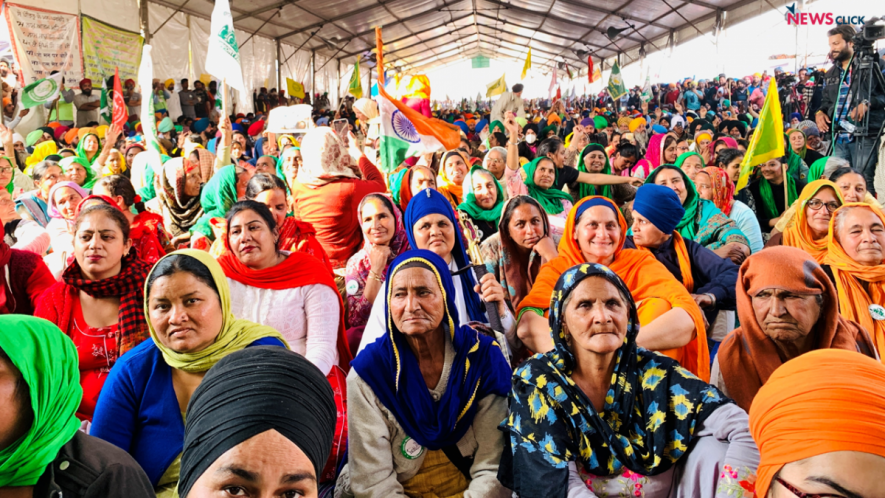Farmers' Struggle and Women’s Participation

File Photo.
A striking facet of the ongoing farmers’ movement is the large-scale participation of women. Women, both farmers and otherwise, from different parts of the country have been actively participating in these protests, both at Delhi’s borders as well as in the various protests in a number of states. The estimated number of women participants at the protest sites at Delhi borders is about 10,000. Since January 28, the Mahapanchayats and Maha Rallies held in various parts of India have also witnessed a large number of women participants.
These women belong to different classes, but majority of them are from farmer households and manual worker households. Given that women have had lower mobility, even in terms of employment, due to the manner in which social constraints unequally impinge on them, their participation now may be attributed to their perception that the three farm laws will not only adversely affect employment and income but will also increase food insecurity for women.
Exclusion from land market and agricultural income
Even before the three farm laws were enacted by the BJP-led government at the Centre, agriculture was becoming non-viable for small and marginal farmers due to a number of factors such as the rise in cost of cultivation along with a fall in public investment, lack of subsidies, termination of agricultural extension, etc. The encroachment of corporate agribusiness into agricultural trade (both through direct purchases and contracts), that is unregulated, would adversely affect private procurement prices in agriculture and even more so if public procurement atrophies. The provisions of agricultural trade and contract farming in the three farm laws seek to provide private corporate agribusiness unregulated access to agricultural markets, which would aggravate the crisis facing small and marginal farmers.
The Periodic Labour Force Survey 2018-19 points out that around 71% of women in India are engaged in agriculture. Further, the data of agriculture census 2015-16 indicates that about 13.87% women farmers operate 11.57% of agricultural land. Despite having a larger share in the agricultural workforce, women have disproportionately low levels of land ownership and operational holdings. Even this limited control or possession of agricultural land rights by women has largely arisen due to growing migration of rural men and cases of suicide by male farmers.
The share of women farmers in Indian states presents a very interesting picture. In some of the geographically large states such as Andhra Pradesh (27.2%), Telangana (22.4%), Karnataka (17.8%), Tamil Nadu (17.4%t), Gujarat (15.9%) and Kerala (15.8%), women have a relatively higher share compared to the national average, as per the Agriculture Census 2015-16. However, Punjab records a very low share of women farmers (1.1%). The largest share of women farmers, in India, belongs to the marginal (13.7%) and small (13.3%) categories of agricultural landholding. The proportion of women farmers starts declining with the increase in the household holding. With the corporate encroachment into agriculture, the landless households and women will be excluded from land ownership with greater land concentration in rural areas.
Corporate encroachment will further marginalise women, depriving them of agricultural land, credit and product markets due to the systemic gender oppression, which is manifested in the form of lower mobility and low levels of education. A study about women farmers and workers from Maharashtra by Mahila Kisan Adhikar Manch (MAKAAM) in 2020 points out that 74% of the women farmers sold their produce outside the APMC market yards for reasons such as immediate payment, lack of necessary documentation for sale in APMC mandis and due to hurdles they face in bargaining in a system that disempowers them. Further, the exclusion of women from the agricultural market and non-viability of agriculture would result in an increase in the incidence of reverse tenancy (small farmers leasing out to rich and capitalist farmers) among the small and marginal women farmers and some of them may even exit agriculture and lose their livelihoods.
Also read: Protest Sites at Delhi’s Borders See Farmers, Workers Unite to Fight Farm Laws
Reduction in wage employment and wages
Import-oriented production and large-scale expansion of contract farming along with encroachment of corporate agribusiness in agriculture, would also tend to alter the cropping pattern, moving further towards mechanised production. Besides undermining domestic food security, large-scale mechanisation of agriculture would also reduce the employment of manual workers (of all genders) in agriculture. Women who have had relatively lower employment mobility would be further adversely impacted. This came out in our village study (2015) of Gang Canal region (Rajasthan), where the cropping pattern had shifted from cotton to guar (cluster beans) due to the increased international oil prices. The shift towards guar, a mechanised crop in 2010-11, reduced the number of days of employment for women wage workers by 69% (from 51 to 19 days). The women workers were previously involved in weeding and in harvest and post-harvest operations involving cotton. The impact of the changes in the cropping pattern was particularly adverse for women workers, who were mainly wage workers in agriculture due to the lack of alternative employment opportunities. Women workers who were displaced from the farm activities started working in the non-farm sector, but opportunities and scope in the latter have been limited, resulting in a decline in rural female employment. Rural male workers sought work in the informal sector in neighbouring towns and villages, but most women workers, due to systemic gender oppression, could not seek work outside agriculture. Therefore changes in cropping patterns which involve greater mechanisation have resulted in the creation of large rural female surplus labour.
Changes in the production process in rural areas have adversely impacted wage employment in agriculture in two ways: first, by replacing workers in agriculture with machines; and, secondly, by reducing the average days of wage work.
A large number of APMC mandis, especially the better organised ones, provide employment to women workers in cleaning, loading and in other related activities. During the Covid-19 lockdown, both male and female workers were able to secure employment for a few days in the APMC mandis. If these APMC mandis are bypassed in agricultural trade after the imposition of three farm laws, it may result in a decline in female wage employment in such activities because of the modernised structure of private mandis and also the storage. This decline in employment in agricultural production, trade etc. would consequently impact the bargaining power of workers adversely, especially women workers.
Rise in food insecurity, impact on women
It can also be argued that the three farm laws will increase food insecurity in India. According to the hunger index 2020, India ranks 94 among the 107 counties. The data of the National Family Health Survey (NFHS-5) 2019-20 showed that in 13 out of 22 States and UTs, more than half of women and children are anaemic. Also between 2015-16 and 2019-20, the incidence of anaemia has increased. Women tend to be disproportionately anaemic or food insecure in other ways. The implementation of the farm laws would result in a shift towards export-orientated crops (away from food crops), resulting in a fall in domestic food availability. Further, if public procurement of food crops declines, then the resultant shrivelling of the public distribution system will lead to a rise in domestic food prices.
The Essential Commodities (Amendment) Act, 2020, in which the stock quantity and supply regulation that pertains to the private entities has been amended, enabling corporate agribusinesses to maintain large speculative stock holdings of agricultural produce including pulses, cereals, edible oilseeds and oils, onions, and potatoes. According to Essential Commodities (Amendment) Act, 2020, only in “extraordinary” circumstances, such as war, famine, natural calamities or steep price rise, namely 100% increase in retail price (in the case of horticultural produce) and a 50% increase in retail price (in the case of non-perishable agricultural food items), can the government step in to regulate the trade in these agricultural commodities. Under these circumstances, if the public distribution system is sought to be replaced with a direct cash transfer scheme, food insecurity will tend to increase. This would be the case since a government that is committed to the neoliberal project is unlikely to ensure that the cash transfer is adequate to meet the food requirement as specified in the public distribution system. An atrophy of the public procurement of agriculture produce would not only negatively impact the public distribution system, but also lead to undermining of various food and nutrition schemes such as mid-day meals, Integrated Child Development Services, etc. The erosion of these schemes can result in increased incidence of malnutrition and anaemia among women and children.
Women’s participation in the protests against the farm laws has led to a rise in their understanding and organisation, as evidenced by the large mobilisation on Mahila Kisan Diwas (January 18). However, women are not passive participants in the farmers' struggle. They are aspiring to make the protest more inclusive, for instance, by demanding that non-inclusive slogans, speeches, songs, etc. should not be part of the struggle. They have achieved a fair degree of success in this endeavour for a more inclusive struggle.
Women in Punjab and Haryana are also carrying out a significant part of most of the agricultural activities especially since many rural men are participating in the protest at locations away from their farms. But efforts to make the farmers' struggle against the corporate takeover of agriculture more inclusive, attention also needs to be paid to the fight against gender oppression.
The author teaches economics at Janki Devi Memorial College (University of Delhi).
Also read: Liberalisation of Agriculture: Lessons from Developed and Developing Countries
Get the latest reports & analysis with people's perspective on Protests, movements & deep analytical videos, discussions of the current affairs in your Telegram app. Subscribe to NewsClick's Telegram channel & get Real-Time updates on stories, as they get published on our website.






















